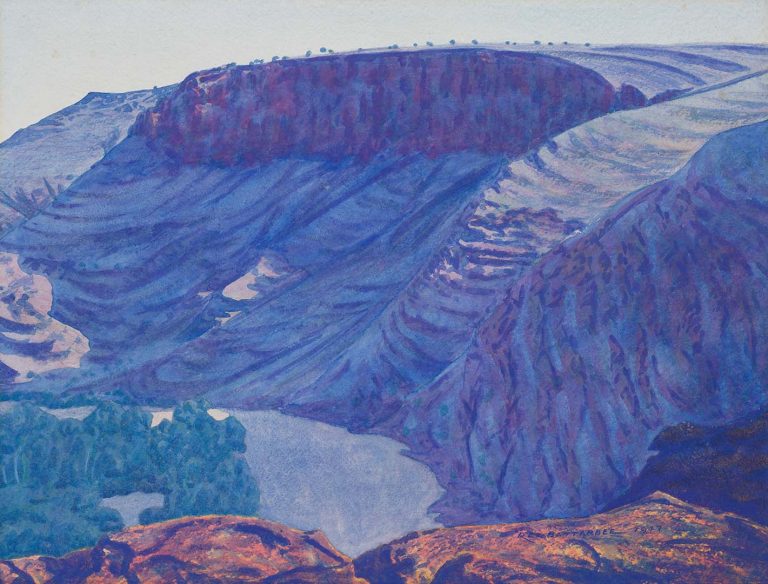We acknowledge the Traditional Owners of the land on which the Queensland Art Gallery | Gallery of Modern Art stands and recognise the creative contribution First Australians make to the art and culture of this country.

Rex Battarbee / Australia 1893–1973 / (Central Australian landscape) 1947 / Watercolour over pencil on paper on cardboard / 39.9 x 52.7cm / Purchased 2001. Queensland Art Gallery Foundation Grant / Collection: Queensland Art Gallery / © Estate of the artist
Rex Battarbee(Central Australian landscape) 1947
Not Currently on Display
Rex Battarbee’s (Central Australian landscape) 1947 provides an unusual perspective — the viewer enters the scene as the artist would have done, atop a rocky escarpment, which drops away to a deep ravine. The eye follows the undulating rock formations around to a flat-topped outcrop, set high against the horizon, or spirals rhythmically downwards to the valley and scattered trees below. This vertiginous effect is accentuated by the violet-blue and pink hues that Battarbee has employed — quite accurate for the region surrounding the MacDonnell Ranges where he worked, but striking nevertheless. These vivid tones are contrasted against the more muted red, gold and orange colours of the mesa in the foreground. This watercolour is somewhat of a departure for Battarbee, and his palette was rarely as strident. His more conventional vistas, painted at ground level, often depicted still pools or white ghost gums in the foreground and a mountain range in the mid-distance.
Rex Battarbee was born in Warrnambool, Victoria, in 1893. He began painting with watercolour during his recovery from wounds he sustained during World War One.
Battarbee first explored Central Australia with John A. Gardner in 1932. Two years later he won the Melbourne Centenary Prize for best watercolour for his painting depicting the MacDonnell Ranges. During a subsequent trip to the Centre, he focused his artistic efforts on Hermannsburg and the area around the Finke River Aboriginal Mission, where he and Gardner held an exhibition in 1934.
Battarbee and Gardner’s work attracted the interest of the local Arrernte (Aranda) people, and Albert Namatjira in particular. Battarbee returned to the district alone in 1936, and together he and Namatjira planned a two-month painting expedition ‘… in which each was to contribute to the other’s knowledge’.1
Battarbee was integral to the development of the Hermannsburg School of Painters, and organised exhibitions of the region’s artwork in capital cities around Australia. He was a member of the Aranda Arts Council from 1943 and its chairman from 1951–56.
Endnotes:
1 Rex and Bernice Battarbee, Modern Aboriginal paintings, Rigby, Adelaide, 1971.
Edited from Essay by Samantha Littley, Research Assistant, Australian Art, 14.02.01.